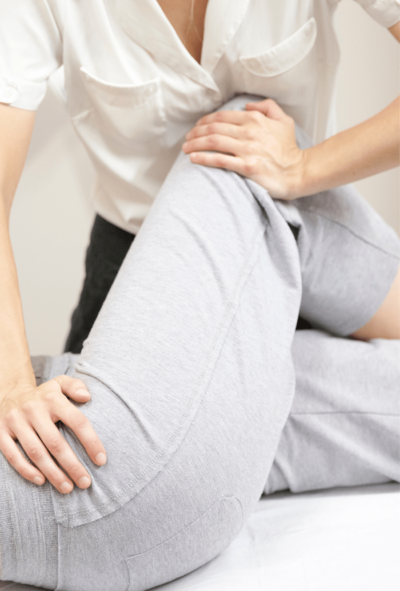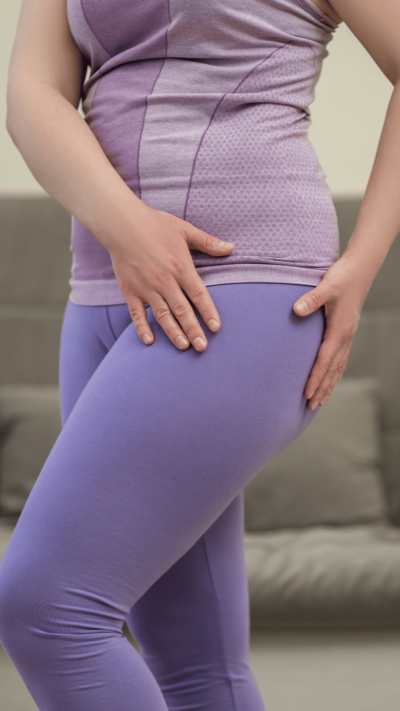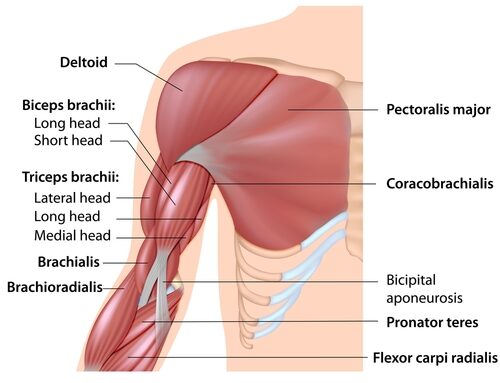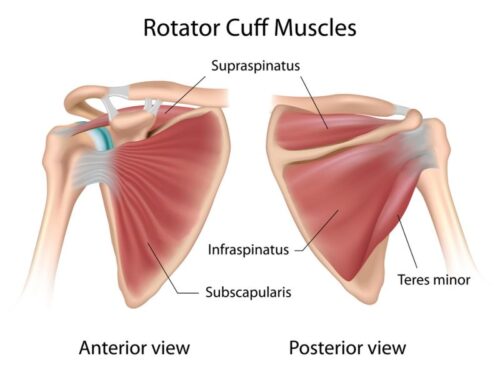DOES MASSAGE WORK FOR BURSITIS?
A bursa is a small, flat fluid filled sac that reduces friction between tendons and bones. Bursitis is inflammation of the bursa, caused by overuse.
Imagine having a tiny cushion in your joints called a bursa. This small, flat, fluid-filled sac acts like a buffer, reducing friction between tendons and bones. When the bursa gets inflamed due to overuse, it results in a painful condition known as bursitis.
Several factors can increase the likelihood of developing bursitis. Muscle imbalances, poor biomechanics, postural problems, and lack of flexibility all contribute to this uncomfortable condition.
Bursitis often strikes in the shoulder, hip, elbow, and knee—areas that endure a lot of movement and pressure. The pain it causes is deep and burning, whether you’re at rest or active. You might notice heat and swelling around the affected joint, which can significantly limit your range of motion. Additionally, bursitis often goes hand in hand with tendinitis, making movement even more challenging.
Understanding these aspects of bursitis can help you take proactive steps to manage and prevent it, ensuring you maintain a healthy, active lifestyle.
How does massage therapy work for bursitis?
Bursitis of the hip often causes significant hip pain and discomfort, impacting daily activities. Incorporating friction massage into your treatment plan can provide targeted relief. Additionally, cases of shoulder bursitis may also benefit from deep tissue techniques, helping to relieve associated shoulder pain.
Massage therapy focuses on the affected area, reducing pain and stiffness. Techniques like myofascial release promote healing by improving circulation and reducing muscle tension. In chronic cases, massage can help manage pain and prevent further inflammation.
For those experiencing shoulder or neck pain due to bursitis, a comprehensive massage plan can help relieve symptoms and improve the range of motion. Massage’s therapeutic effects extend beyond immediate relief, supporting long-term healing and overall well-being.

Self-Care Tips to Help Relieve Bursitis Pain
Taking care of yourself between massage sessions is crucial to managing bursitis and preventing flare-ups. Here are some practical self-care tips to help you stay on top of your condition:
- Stretch Regularly: Incorporate gentle stretching exercises into your daily routine to maintain flexibility and reduce muscle imbalances. Focus on stretches that target the hip, shoulder, and other affected joints to improve your range of motion and alleviate muscle tension.
- Exercise Wisely: Engage in low-impact activities like swimming or cycling to keep your joints moving without adding too much strain. Regular exercise can help strengthen the muscles around your joints, providing better support and reducing the risk of inflammation.
- Use Ice and Heat Therapy: Applying ice to the inflamed bursa can help reduce swelling and numb the pain. Use an ice pack wrapped in a towel and apply it to the affected area for 15-20 minutes several times a day. Heat therapy can be beneficial for chronic discomfort. Use a warm compress or bath to relax the muscles and improve blood circulation.
- Maintain Good Posture: Poor posture can exacerbate bursitis symptoms. Be mindful of your posture while sitting, standing, and moving. Use ergonomic chairs and supportive cushions to align your body and reduce joint strain.
- Practice Soft Tissue Massage: Between professional massage therapy sessions, gently massaging the affected area can help relieve muscle tension and promote relaxation. Use slow, circular motions to target the muscles around the inflammation of the bursa.
- Stay Hydrated: Drinking plenty of water helps keep your muscles and joints lubricated, reducing the risk of irritation and inflammation. Aim for at least 8 glasses of water a day to stay hydrated.
- Consult with a Professional: If you experience persistent pain or discomfort, it’s essential to seek advice from a healthcare professional. They can provide tailored recommendations and ensure your self-care routine is effective and safe.
- Avoid Lying on it. Whenever possible, avoid laying on the joint that has bursitis, especially trochanteric bursitis of the hip joint, as this will aggravate it further.
Following these self-care tips can help manage your bursitis symptoms and support your overall well-being. Remember, regular massage and proactive self-care is the key to finding relief and maintaining a healthy, active lifestyle.
Top 3 Types of Massage for Bursitis Relief
Finding the right type of massage can significantly improve recovery and overall well-being when dealing with bursitis pain. Here are the top three types of massage that can help alleviate the symptoms of bursitis, each offering unique benefits to target inflammation, reduce pain, and improve mobility.
- Deep Tissue Massage:
- Why It Helps: Deep tissue massage targets the deeper muscles and connective tissue layers. It’s particularly effective for breaking down adhesions and scar tissue, alleviating chronic pain, and improving mobility. Reducing muscle tension around the inflamed bursa helps relieve pain and promote healing.
- Swedish Massage:
- Why It Helps: Swedish massage uses long, gliding strokes, kneading, and circular movements to relax the entire body. This type of massage increases blood flow and lymphatic circulation, which helps reduce swelling and inflammation associated with bursitis. The gentle, soothing techniques also provide overall relaxation, reducing stress and muscle tension.
- Myofascial Release:
- Why It Helps: Myofascial release focuses on the fascia, the connective tissue surrounding muscles and organs. This technique involves applying sustained pressure and stretching to release tightness and pain. By targeting the fascia, myofascial release can help improve flexibility, reduce pain, and enhance the range of motion in the affected joints, making it ideal for those suffering from bursitis.
When applied by a skilled massage therapist, these massage techniques can significantly alleviate the symptoms of bursitis, providing relief and improving your overall quality of life. Be sure to communicate with your therapist about your specific needs and any areas of concern to ensure the best possible results.

Benefits of Massage Therapy for Bursitis Hip Pain
Incorporating massage therapy into a comprehensive treatment plan for bursitis hip pain can provide many benefits. These benefits include:
- Pain Reduction: Massage therapy effectively reduces pain and discomfort associated with bursitis hip pain. Massage can help alleviate the sharp, aching, or burning sensations by targeting the inflamed bursae and surrounding tissues.
- Improved Range of Motion: Massage therapy can help increase the range of motion in the hip joint, allowing individuals to move more freely and with less discomfort.
- Reduced Inflammation: Massage therapy techniques, such as effleurage and petrissage, can help reduce inflammation in the affected bursae, promoting healing and reducing swelling.
- Enhanced Relaxation: The soothing touch of a skilled massage therapist can help reduce stress and anxiety, allowing individuals to find relaxation and peace amidst the pain.
- Improved Quality of Life: By alleviating the physical and emotional burden of bursitis hip pain, massage therapy can significantly improve an individual’s overall quality of life, enabling them to engage in daily activities and enjoy a more active lifestyle.
What to Expect During a Massage Therapy Session for Bursitis Hip Pain
During your massage therapy session for bursitis hip pain, you can expect the following:
- Assessment: Your massage therapist will begin by assessing the affected area, evaluating the range of motion, identifying any areas of tenderness or inflammation, and developing a customized treatment plan.
- Massage Techniques: The therapist will then apply various massage techniques, such as deep tissue, trigger point therapy, and myofascial release, to target the inflamed bursae and surrounding tissues.
- Pressure and Comfort: The massage therapist will adjust the pressure and techniques based on your feedback, ensuring the treatment is comfortable and effective.
- Stretching and Mobility Exercises: Besides the massage, the therapist may incorporate gentle stretching and mobility exercises to help improve range of motion and reduce tension in the hip area.
- Aftercare Recommendations: After the session, the therapist may recommend at-home care, such as applying ice or heat, performing specific exercises, or incorporating other therapies to support the healing process.
It’s important to communicate openly with your massage therapist throughout the session, providing feedback on the pressure, technique, and any areas of discomfort or sensitivity. This collaboration will help ensure the most effective and comfortable treatment for your bursitis hip pain.

Recovery Timeline and Medical Treatment for Bursitis
The recovery time for bursitis can vary depending on the severity of the condition and the effectiveness of the treatment plan. Generally, with appropriate care, mild to moderate bursitis can start to feel better within a few weeks. However, chronic or severe cases may take several months to resolve fully.

Regular massage can play a crucial role in managing and alleviating bursitis symptoms. Whether dealing with hip pain, chronic inflammation, or shoulder tenderness, targeted massage techniques offer a natural and effective solution. By combining professional massage therapy with proactive self-care, you can experience significant relief and maintain a healthy, active lifestyle.
Don’t let bursitis hold you back any longer. Schedule your massage at Body Ache Escape today and start your journey toward pain relief and improved well-being. Our experienced therapists are here to help you find the perfect treatment plan tailored to your needs. Book your appointment now and take the first step to reclaim your comfort and mobility.





